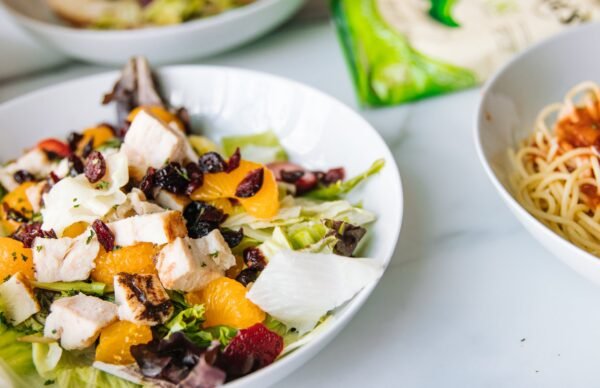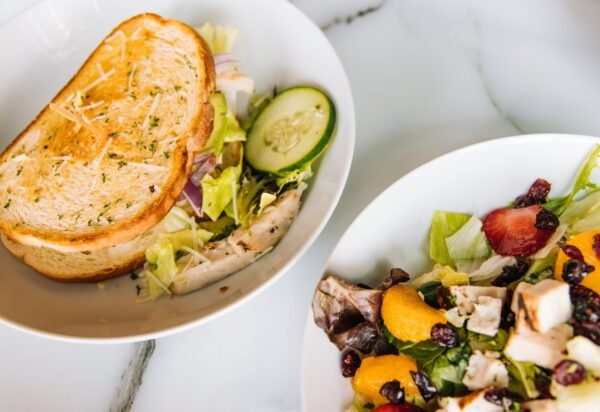
Picnics, music festivals, family gatherings, and rooftop parties are upon us! It’s officially summer and the good times are rollin’. But sometimes summer brings unwanted anxiety and pressure about food choices, our bodies, and keeping up a certain routine. Fear not, as we have spoken to Ashleigh Kidd, Dietitian at F45 Training (www.f45training.co.uk), who shares her six tips on how to stay present and enjoy your summer while maintaining realistic health habits.

Avoid quick fix diets
I know the promises of quick fix diets can feel like the right idea, a lot of us have been there! These diets provide a short-lived sense of control, but before you know it, food rules and the “all or nothing” mindset begin to take over. This can lead to a poor relationship with food, lower base metabolic rate, weight gain or regain in the long term, and negative effects on mental health.
Here are some dieting red flags to look out for:
● Cutting out a food group or macronutrient (carbs are popularly shunned- but they are essential!)
● Demonizing fruit (i.e. bananas are “bad” because they have too much sugar. Spoiler alert, bananas provide fiber, antioxidants, and micronutrients)
● Labeling food as good/bad (while some foods are more nutrient dense than others, food doesn’t have moral value!)
● Extreme calorie restriction (1200 calories is not enough)
● Promises a quick fix (i.e. in 1 month you’ll lose 20lbs!)
● Food rules (you can’t eat after 6pm)
● Wildly false claims (pro tip: there are no fat burning foods)
Balance your plate
Try to balance your plate most of the time. A balanced plate helps you to leave the meal satisfied physically & mentally, lean into your body’s hunger cues, and build body trust. Whether you are cooking at home or out to eat with friends, you can think of these key meal components and try to create balance when possible:
● Protein: Aim for about ¼ of your plate to be protein (can be animal or plant protein). This may vary depending on your body’s specific needs and goals
● Fat: Fat will help to keep you full and satisfied. It’s likely already in your meal through cooking oils, animal protein, or sauces. If not, try adding some- like avocado!
● Carbohydrates: Fill about ¼ of your plate with carbs (i.e.rice, pasta, sweet potato)
● Color: Pick your favorite veggies and/or fruit to take up ½ your plate. Try choosing a different color veggie or fruit at each grocery store visit for variety.
Don’t “save up” calories for a night out
POV: It’s 12pm, you’re starting to get hungry, but you hesitate because you’re going out for dinner and drinks this evening. It’s easy to think that “saving up” calories is a good idea in anticipation of eating a large meal or going out later in the day. However, doing so will likely leave you feeling out of control at your next meal, eating past fullness, and feeling very uncomfortable. Instead, eat how you normally would that day so that you can be present and mindful later on.
Eating consistent meals/snacks throughout the day and not skipping meals can help by:
● Providing consistent energy
● Avoiding the 3pm slump
● Balancing blood sugars
● Decreased chance of binge eating or overeating at the end of the day
● Improved mood
Practice Mindfulness
When it comes to our food choices, practicing mindfulness helps us get in tune with our hunger/fullness cues. It can even increase our overall level of food satisfaction because as we focus on our awareness, experience, and actions of meal preparation and consumption, we are more likely to eat foods that are enjoyable and nourishing to us.
Don’t know where to start? Try implementing one of these at your next meal:
● Minimize distractions & be present (practice putting the phone down)
● Assess your hunger/fullness (before, during, and after your meal- use a hunger/fullness scale for additional help)
Include your favorite foods
Satisfaction is key! This might sound like a no-brainer, but it’s important to include foods you actually enjoy in your meals and snacks. If not, you’ll likely leave meals feeling unsatisfied (even if you’re full), and may lead to overeating later.
Cutting foods out that you perceive as “bad” only puts them on a pedestal. This can lead to increased or obsessive thoughts about that food and even increased consumption. This is because when you’re finally around that food again (i.e. at a friend’s birthday party), you might eat as much as you possibly can because you don’t know when the next time you’ll actually allow yourself to eat it will be. Then you “start over Monday” and the cycle continues.
Make your life easier
Processed foods typically get a bad rap, but the truth is, having some convenience foods on hand can actually make it easier to maintain healthy habits and achieve your nutrition goals. I’m not suggesting you eat heavily processed foods at every meal, but sometimes processed foods (which only means that a food has had something done to it that alters their natural state, i.e. slicing an apple), can be a great way to help us balance our meals (like frozen veggies), especially when we’re pressed for time.
Convenience food staples:
● Frozen produce (hello thick & creamy smoothies)
● Salad kits
● Pasta
● Canned tuna (easy protein!)
● Peanut butter
● Canned beans (look for low sodium options)
● String cheese
● Frozen protein waffles (top with PB, chia seeds, and blueberries for a balanced breakfast on the go)
● Ready to serve rice or quinoa
● Chicken tenders (pro tip: add this to your salad kit when you’re in a pinch)
Written by Ashleigh Kidd, Dietitian at F45 Training (www.f45training.co.uk)
